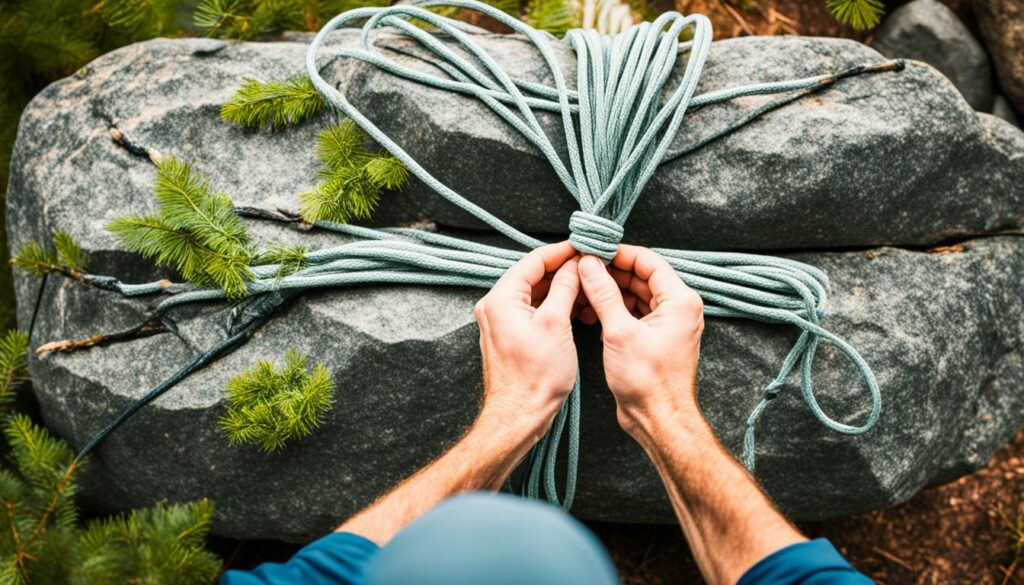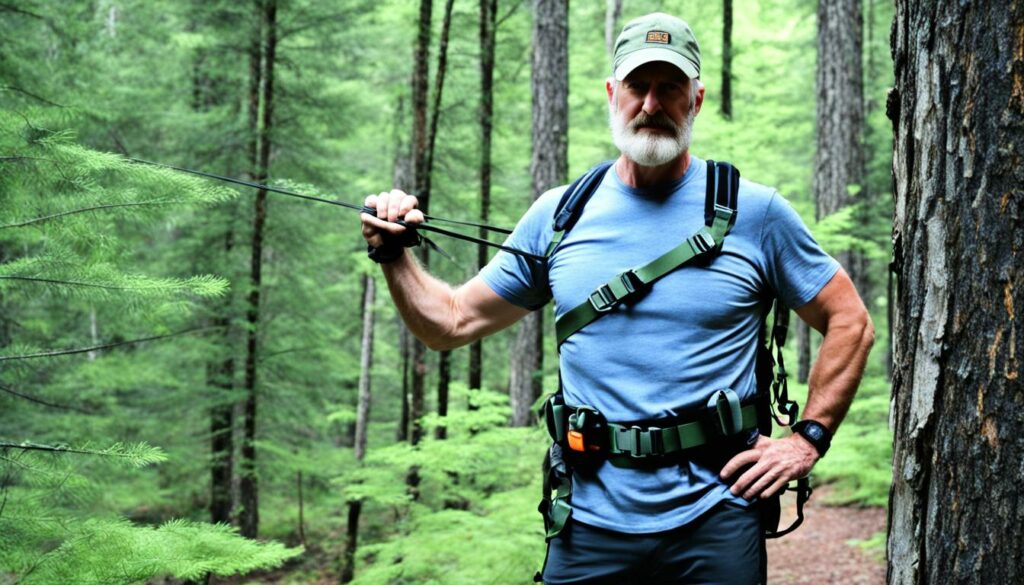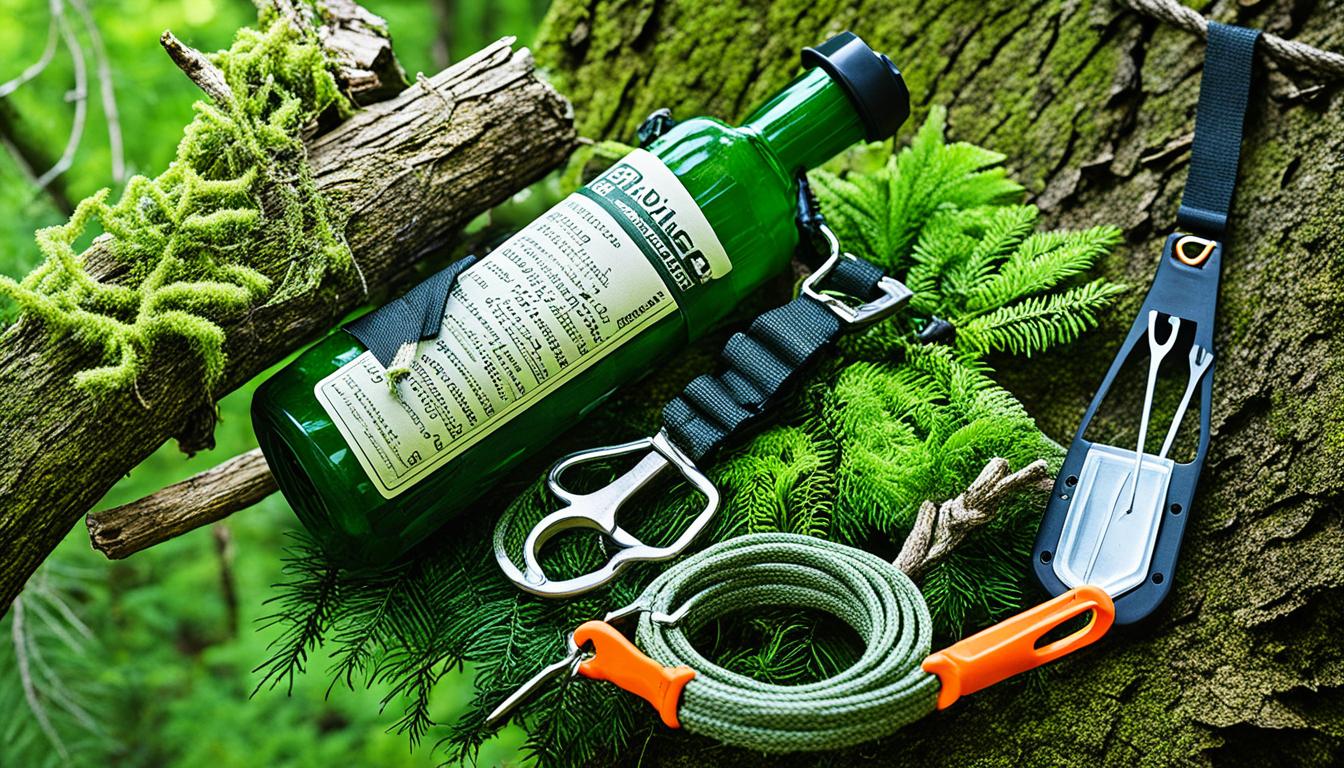Learn how to make a survival sling, a tool as deadly as a .44 Magnum. This guide will teach you to make your own sling. It’s key for wilderness survival. You’ll see how it helps with hunting and self-defense.
If you love the outdoors, enjoy bushcraft, or want to be ready for emergencies, this is for you. You’ll get step-by-step instructions and throwing tips. This will help you make your own survival sling and be more self-reliant outside.
Key Takeaways
- Discover the historical significance and ancient origins of the survival sling
- Learn to craft your own DIY survival sling using readily available materials
- Understand the step-by-step process of creating the sling’s pouch and attaching the cords
- Master the overhand and underhand throwing techniques for accurate and powerful shots
- Explore the versatility of the survival sling as an emergency tool and for hunting small game
Introduction to the Ancient Survival Sling
The survival sling has a long and interesting history. It goes back thousands of years. People used it all over the world, almost everywhere, as a key tool for early humans.
Old-time slingers were very good at hitting their targets. They could throw stones through small openings from up to 50 yards away. They used it for hunting, in wars, and to help with herding animals.
The story of how the sling evolved is really interesting. The first slings go back to the Paleolithic era. Over time, they got better with special pouches and better cord designs.
Looking into archaeological findings on slings shows how smart our ancestors were. They used this simple tool to survive and do well in the wild. Let’s dive into the history and importance of the ancient survival sling together.
| Sling Characteristics | Ancient Sling Usage |
|---|---|
| Pouch and cord construction | Hunting, military, herding |
| Accurate range of up to 50 yards | Widespread use across continents |
| Evolution from Paleolithic era | Survival and resource gathering |
“Slingers of the past were renowned for their remarkable accuracy, capable of launching stones through narrow hoops with impressive precision from distances of up to 50 yards.”
Materials Needed for Your DIY Survival Sling
Making your own survival sling is a great skill for outdoor adventures or emergencies. You can find the survival sling materials easily and they don’t cost much. With just a few basic items, you can make a useful and strong makeshift sling.
You’ll need these diy sling components to start:
- A sturdy, sharp knife for cutting the leather or fabric
- A piece of leather or thick cloth, like from an old jacket or shoe
- Approximately 18 inches of cordage or strong string
The primitive sling construction is easy. First, cut the leather or cloth into a diamond shape, about 4 inches wide. Then, punch two holes at the ends of the diamond. After that, thread the cordage through the holes to make the pouch for your survival sling toolkit.
With these simple diy sling components, you can make a useful survival sling. It’s great for hunting, fishing, or self-defense in emergencies. Its easy design makes it a must-have for outdoor lovers’ makeshift sling supplies.
Step-by-Step Guide to Making the Survival Sling
Making your own DIY survival sling is a great skill. It involves designing the pouch, attaching the cords, and adjusting the length. Each step is key to making a useful survival tool. Let’s look at how to make your own survival sling.
Creating the Pouch
Begin by making a pouch template with cardboard and everyday items. The main circle should be about 10cm wide, with two smaller 5cm circles next to it. Move this design to your material, like leather or thick fabric, and cut it out.
Punch two holes on each side for the cords. This makes the pouch secure and balanced.
Attaching the Cords
Next, attach the cords that will hold the pouch up. Use strong stuff like paracord or nylon. Make sure the cords are long enough for your arm to bend at a 90-degree angle with the survival sling on.
This makes sure you can hold it comfortably and control it well.
Adjusting Cord Lengths
After putting the cords in, adjust their lengths so the pouch hangs evenly. This stops the pouch from falling or rolling when you throw it. Try different cord lengths until you find the best balance for your hand and arm.
By doing these steps, you’ll make a durable and effective DIY survival sling. It will be a great help in outdoor adventures or emergencies.
How to Create a Survival Sling
Making your own survival sling is a great skill. It’s useful for outdoor adventures or as a self-defense tool. Let’s learn how to make your own primitive sling.
Start by getting your materials. You’ll need leather or canvas for the pouch, strong cord or paracord, and a sharp tool. With these, you can begin making your diy sling.
Assembling the Survival Sling
First, thread a cord through the pouch’s holes and tie a knot. Do the same with the second cord. Make sure the pouch hangs straight when you hold the survival sling.
Adjust the cord lengths for a good fit. Once done, your homemade survival sling is ready to use.
“The survival sling is a versatile and ancient tool that has stood the test of time. Mastering its creation and use can be a valuable asset in any outdoor adventure or survival situation.”

With your survival sling, try different throwing techniques. Practice your aim and even hunt small game. Making your own diy sling is rewarding. Enjoy the process and feel proud of your primitive sling.
Mastering the Throwing Techniques
Using a survival sling well takes practice. You need to learn different throwing ways. The overhand throw and the underhand throw are two main ways to throw with a survival sling.
Try both the overhand sling throw and underhand sling throw to see what works best for you. Pick a big, open place to practice your sling target practice. Make sure it’s safe and you know what you’re aiming at before you start.
Overhand Throw
- Grip the sling with your main hand, keeping it open and the projectile inside.
- Move your arm up high, stretching it out and letting the sling swing back behind you.
- When the sling goes up high, let go of the projectile by opening your hand. This makes it fly forward with power and aim.
Underhand Throw
- Hold the sling with your main hand, keeping it open and the projectile in place.
- Bring your arm back, letting the sling swing down and behind you.
- When the sling goes down, let go of the projectile by opening your hand. This sends it forward smoothly and with control.
Getting good at these survival sling throwing techniques takes time and practice. But, it’s really useful to know how to use this old tool.
Safety Precautions and Responsible Use
The survival sling is a powerful tool that needs careful handling. It can launch projectiles with a lot of force. This makes it dangerous if not used right. As a sling weapon fan, it’s key to focus on sling safety and sling usage guidelines. This keeps your activities safe, right, and legal.
When you’re using or hunting with your survival sling, be very careful to avoid accidents. Make sure you see your target clearly and have a safe place for any stray shots. Never aim at people, animals, or things you don’t mean to hit. Learn about sling hunting ethics and rules in your area before you start.
Use the survival sling with respect and care. Know the sling projectile risks and treat your sling with the respect it needs. By being sling weapon responsible, you can have fun and stay safe with this ancient tool.
| Safety Tip | Description |
|---|---|
| Clear Target | Make sure you can see your target clearly before you shoot. |
| Suitable Backstop | Use a thick, soft material to catch stray shots and prevent damage or injury. |
| Hunting Regulations | Learn the laws and rules about using slings for hunting and fun. |
| Ethical Considerations | Use your sling with a strong sense of right and wrong. Respect its power and its effect on nature and animals. |
Follow these survival sling safety tips and use it responsibly. This way, you can have fun and stay safe with this ancient tech in your outdoor adventures and survival plans.

Hunting with Your Survival Sling
The survival sling is great for hunting small game like rabbits, birds, and squirrels. It’s key to watch for animals that stop and look around. This can be your chance to shoot.
Identifying Suitable Game
When using your sling for small game, pick targets you can hit within its range. Make sure you’re skilled enough for a humane and right hunt.
Stalking and Hunting Techniques
Use sling hunting techniques to sneak up on your prey. Be quiet and use sling stalking and tracking to find the best shot. With time and patience, your sling can help you find food in the wild.
| Small Game Suitable for Sling Hunting | Effective Range |
|---|---|
| Rabbits | 15-25 yards |
| Squirrels | 20-30 yards |
| Birds | 10-20 yards |
“With practice and patience, you can use your survival sling to supplement your food supply in the wilderness.”
Practicing and Improving Your Skills
Mastering the survival sling means practicing often. Find a safe spot like a riverbank or field for practice. Use objects to shoot at, moving them back as you get better.
The sling lets you practice a lot without running out of ammo. Working hard and practicing often makes you better. This helps you feel more confident when you really need the sling.
“Consistent practice is the key to mastering the survival sling. Dedication to regular training will translate to greater confidence and effectiveness when using the sling in a survival scenario.”
Begin with the overhand throw and underhand throw. Keep your form right and control your throws. Then, try different angles and speeds to get better.
Practice makes the survival sling easy to use. Enjoy learning and seeing your skills get better with each shot.
Survival Sling as an Emergency Tool
The survival sling is more than just for hunting. It’s a key emergency tool for the outdoors. It’s easy to carry, simple to use, and does many things. This makes it a great addition to any survival kit.
In a crisis, the survival sling helps with self-defense. It’s quiet and doesn’t need ammo. This makes it perfect when you need to be quiet and smart to survive.
It can also help you catch small game for food. This is very important when food is hard to find. Learning how to use the survival sling can really help you survive outdoors.
| Survival Sling Emergency Uses | Advantages |
|---|---|
| Self-Defense | Quiet, effective, and ammunition-free |
| Small Game Hunting | Provides sustenance in resource-scarce environments |
| Wilderness Survival | Versatile, portable, and easy to use |
Learning about the survival sling can save your life in an emergency. It helps with threats, finding food, and surviving the wild. The survival sling is a key tool to have with you.
“The survival sling is a compact, versatile tool that can provide a critical edge in emergency situations. Its portability and multifunctional nature make it an invaluable asset in any wilderness survival kit.”
Variations and Customizations
The basic survival sling can be made from easy-to-find materials. But, there’s a lot of room to get creative and try new things. Survivalists have found new ways to make this old tool better and more useful.
Alternative Materials
Look into using different materials like cloth or synthetic fibers instead of leather or cord. This lets you make a sling alternative materials that suits you. You can pick different textures, colors, and patterns to make your DIY sling variations stand out.
Compact and Portable Designs
Some people have made compact survival sling designs that are easy to carry. These portable sling configurations can be taken apart or folded. This makes them great for your emergency kit or bug-out bag. Try different pouch shapes and cord lengths to make a survival sling customization that fits your needs.
| Feature | Traditional Sling | Compact Sling |
|---|---|---|
| Size | Larger, bulky | Smaller, more portable |
| Cord Length | Longer, up to 6 feet | Shorter, around 3 feet |
| Pouch Design | Simple, rectangular | Varied, including folding options |
| Ease of Storage | Less convenient | Easier to store in a survival kit |
The survival sling is very versatile, offering many ways to customize it yourself. Whether you like unique sling alternative materials or small, easy-to-carry designs, you can make it your own. Your creativity is the only limit.
Conclusion
The survival sling is a great tool for outdoor lovers. Making your own gives you a handy, useful, and historic piece of gear. It’s perfect for hunting, defending yourself, or just surviving in the wild.
With practice, this old tech can be a big help in your survival toolkit. It’s important to know about the sling’s history, how useful it is in different outdoor situations, and how making it makes you feel powerful.
To wrap it up, the DIY survival sling is a must for anyone who loves adventure and being self-sufficient. Adding it to your gear shows you care about surviving and respect the old ways.
FAQ
What materials are needed to make a DIY survival sling?
How do I construct the pouch for the survival sling?
What are the different throwing techniques for the survival sling?
How can the survival sling be used for hunting?
What safety precautions should be taken when using a survival sling?
Can the survival sling be customized or modified?
Source Links
- A DiY Survival Sling Shot with Big Game Capabilities – https://survivalsherpa.wordpress.com/2013/08/26/a-diy-survival-sling-shot-with-big-game-capabilities/
- Make a Sling – https://www.instructables.com/Make-a-sling-1/
- Sling – A how to guide for making – https://blog.woodland-ways.co.uk/primitive-crafts/sling-a-how-to-guide-for-making/
